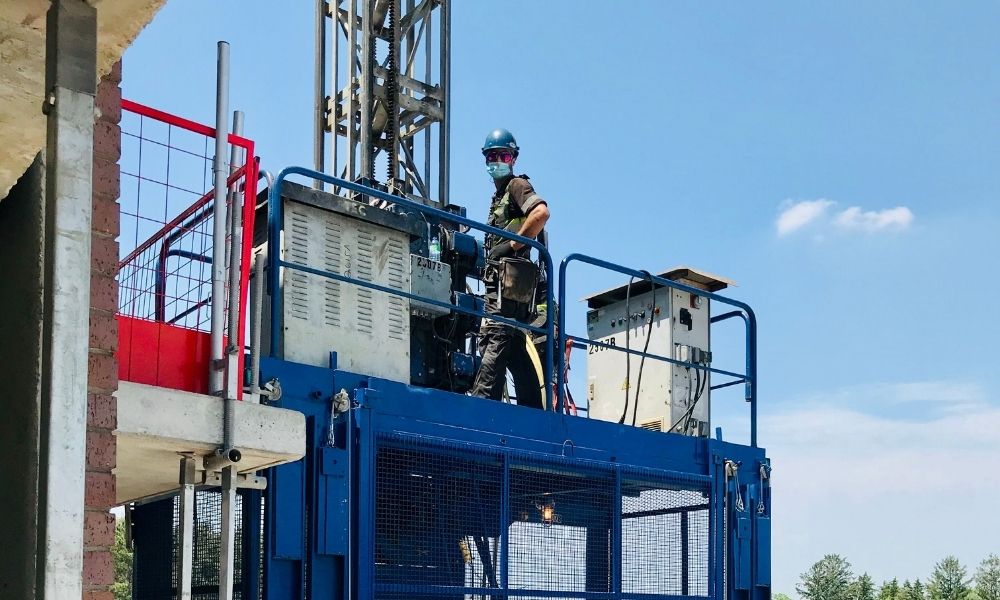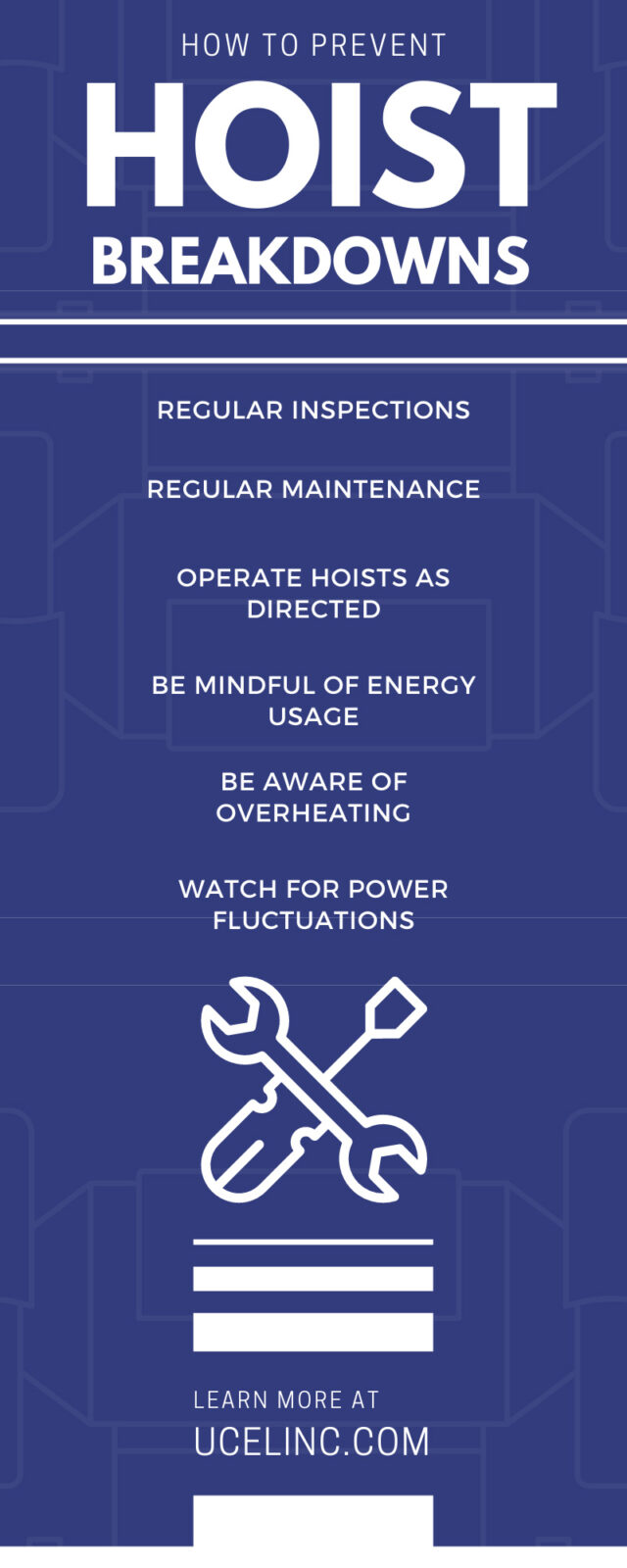Safety and efficiency are critical on any jobsite, especially in the construction industry. While companies strive to ensure safety for their crews and efficiency in their processes, roadblocks still have a way of popping up. One of the most common roadblocks in the construction field are hoist breakdowns. Whether the load brake locks up or the control lever sticks, a malfunctioning construction hoist puts a damper on the workday in more ways than one.
What Is a Construction Hoist?
Construction hoists are powerful pieces of equipment that allow crews to lift, lower, and transport cargo (when installed on a trolley). Hoists are installed on the top of a crane or structure to move heavy tools, construction materials, and equipment from floor to floor. Furthermore, construction hoists are critical to jobsites because they lift and lower cargo safely, quickly, and easily, whereas manual lifting and lowering could be dangerous or impossible.
Common Signs of a Breakdown
Because hoists are used so often, outdoors and they are complex often with 100s of switches and sensors, they tend to break down more than lesser-used machinery. Some of the most common signs a construction hoist is breaking down are:
- The hoist suddenly stops
- Strange noises are heard from the machinery
- The hoist won’t lift it’s rated capacity
Preventing Hoist Breakdowns
From slipping brakes to an overheated motor, a malfunctioning construction hoist is inefficient at best and can present a safety hazard. Thankfully, there are measures that crews and supervisors can take to prevent breakdowns from occurring in the first place. Consider the following ways to prevent hoist breakdowns.
Regular Inspections
One of the best ways to prevent a hoist from breaking down, or from using a hoist when a breakdown or malfunction is imminent, is through an inspection. Operators should carefully inspect construction hoists before each use and communicate their findings based on the local code and manufacturer guidelines – especially if they discover a potential issue. Operators or supervisors should also schedule professional inspections and maintenance the appropriate schedules according to local regulation and manufacturer guidelines.
It is important to note that all construction hoist operators should be adequately trained in inspecting and maintaining the hoists in which they operate. Operators are the first line of defense in the battle against malfunctions, equipment failures, and other signs of breakdowns. While the untrained eye may do an adequate job spotting obvious issues, an operator who is trained in proper inspection techniques will notice things someone else may miss.
When performing a visual inspection, construction hoist operators should check:
- For signs of damage
- For signs of unsafe conditions
- To ensure safety switches are all in good working order.
Regular Maintenance
Simple yet crucial, regular maintenance is one of the best ways crews can prevent their hoists from malfunctioning (or failing to function at all). If a crewmember, supervisor, or other individual finds an issue in the hoist upon inspection, repairs should be made right away and the construction hoist should not be used. In addition, regular maintenance on a well-performing hoist will prevent issues in the future.
Operate Hoists as Directed
While this tip may seem obvious, it’s a crucial piece of advice that some gloss over. Operators may become overly confident in their or the rack-and-pinion hoist’s ability and push the equipment to perform in a way that the manufacturer never intended. An example is ignoring weight limits or wind speed limits. Lifting and lowering materials or equipment that exceeds the hoist’s capacity strains the hoist and could lead to breakdowns or potentially devastating accidents. Operating in high winds can have catastrophic consequences. Workers should never operate in unsafe conditions, and managers should never pressure their workers to do so.
Construction hoist operators should be thoroughly trained and certified in hoist operation. This way, there will be no guesswork around a hoist’s limitations. In addition, operators and supervisors alike must be held to a high safety standard. Supervisors must keep a close eye on personnel to ensure that everyone is adhering to these safety standards.
Be Mindful of Energy Usage
Electric hoists can consume large amounts of energy day in and day out. As the hoist ages, so do its components, leading to inefficient energy consumption and overheating. Operators can keep an eye out for deteriorating performance, and inspections can be done regularly to check on the vitality and efficiency of electrical components. Replacing these components with newer, more energy-efficient models will prevent breakdowns and keep hoists running smoothly, safely, and efficiently.
Be Aware of Overheating
Overheating is a major contributor to electric hoist breakdowns. Construction hoists are installed at the top of a crane and or building, making them fully exposed to the elements. Just as with other pieces of equipment, hot weather and brilliant sunshine may cause lift drives, control systems, resistor banks, and motors to overheat. To prevent breakdowns due to overheating, there are a few preventative steps construction companies can take. The first is to select a company that provides high quality maintenance and equipment which can stand the local elements. The second is to ensure equipment is appropriate for the local environment, asking questions like “is the resistor bank fan-cooled?”, “when is the last time the motors were rebuilt?” or “does the frequency drive exhaust to the outside?” and “do you provide shade covers on your panels?” can help reduce issues on site in high-heat environments.
Watch for Power Fluctuations
As stated above, electric hoists consume a substantial amount of power. Breakdowns can occur if the building’s electricity or system voltage changes while the hoist is in operation. Just as a TV or computer can sustain damage from a power surge, so can electric hoists. While operators and supervisors can’t always prevent a fluctuation in power, they can be mindful of the hoist’s age. The older an electric hoist is, the greater the risk it has of sustaining damage from power fluctuations.
Special electrical protective devices like asymmetry relays, GFCIs, and overloads should be used to prevent these kinds of issues. Make sure whatever equipment you’re getting has modern electrical safety devices installed.
Keep Spare Parts Handy
While this tip has less to do with how to prevent hoist breakdowns, it does provide helpful advice should a breakdown actually occur. To quickly establish a safe environment and minimize downtime, companies should keep spare parts handy on the construction site. If a motor fuse blows, safety latch breaks, or controller sticks, crews can keep things moving by quickly replacing the broken or malfunctioning component.
UCEL is a world-renowned manufacturer of rack-and-pinion hoists and other transport platforms. Contact the team today to learn more about product offerings, rentals, and more.

